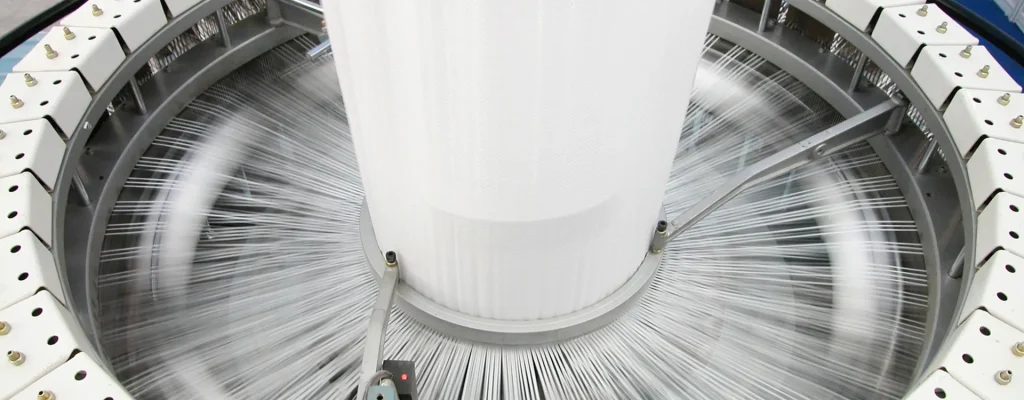
Imagine a conversation between a global supply chain manager and VidePak’s Chief Technology Officer:
Manager: “We need packaging solutions that adapt to both current logistics demands and future sustainability mandates. How can your poly fabric bags evolve with these needs?”
VidePak CTO: “Our polypropylene (PP) woven bags integrate cutting-edge material science and smart technologies—from RFID-enabled traceability to AI-driven durability testing—ensuring they meet today’s operational demands while future-proofing supply chains. With 30+ years of industry leadership, we’ve redefined what ‘durable packaging’ means in the age of Industry 4.0. Let me explain how.”
1. The Historical Journey of Poly Fabric Bags
Poly fabric bags, first commercialized in the 1960s, revolutionized bulk packaging by replacing jute and paper with lightweight, moisture-resistant polypropylene. Early iterations focused on basic functionality, but the 1990s saw advancements like biaxially oriented PP (BOPP) lamination, enhancing tensile strength by 40% and enabling multi-layer barrier designs.
By 2010, the global woven PP bag market reached $12.5 billion, driven by agriculture and chemicals. However, challenges persisted:
- Limited traceability: Manual tracking led to 15–20% logistical errors in bulk shipments.
- Environmental concerns: Non-recyclable coatings contributed to 8 million tons of annual plastic waste.
VidePak addressed these gaps through virgin PP granule adoption and Starlinger circular loom technology, achieving 99.8% material consistency and reducing defects by 90% since 2008.
2. Material Science Breakthroughs in Modern Woven Bags
2.1 Enhanced Polymer Formulations
VidePak’s R&D lab has engineered PP blends with:
- UV Stabilizers: Extend outdoor lifespan to 5+ years (vs. 2 years industry average) per ASTM G154 testing.
- Antistatic Additives: Carbon nanoparticles reduce surface resistivity to 10⁶–10⁹ Ω, critical for flammable powders.
- Recyclable Monomaterials: Single-material structures enable 100% recyclability, aligning with EU Circular Economy targets.
2.2 Advanced Lamination Techniques
| Layer | Function | VidePak Innovation |
|---|---|---|
| Outer PP Woven | Load-bearing (up to 50 kg) | 120 μm thickness, 35 MPa tensile strength |
| BOPP Film | Moisture/Oxygen Barrier | <1 g/m²/day WVTR, 0.8 cc/m²/day OTR |
| PE Inner Liner | Contamination Prevention | FDA-compliant, heat-sealable at 150°C |
Data sourced from VidePak’s 2024 Material Safety Reports
3. Smart Packaging: The Next Frontier
The global smart packaging market is projected to grow at 8.2% CAGR through 2030, driven by traceability demands in food and pharmaceuticals. VidePak’s solutions include:
3.1 RFID & QR Code Integration
- RFID Tags: Embedded chips enable real-time tracking across 120+ countries, reducing shipment losses by 25% in a 2024 pilot with a Brazilian coffee exporter.
- Dynamic QR Codes: Scannable labels provide batch-specific data (e.g., harvest date, carbon footprint), enhancing compliance with EUDR deforestation regulations.
3.2 AI-Driven Quality Control
Leveraging partnerships with AI innovators like The Future Factory, VidePak employs:
- Predictive Analytics: Machine learning models forecast bag stress points, optimizing weave patterns for 50 kg dynamic loads.
- Automated Defect Detection: High-resolution cameras inspect 1,200 bags/hour, achieving 99.99% defect-free output.
4. Case Study: Transforming Agricultural Logistics
A Kenyan tea producer faced 18% spoilage rates due to humidity and counterfeit packaging. VidePak implemented:
- BOPP/PE Laminate Bags: Reduced moisture ingress to 0.5 g/m²/day.
- Blockchain-Linked QR Codes: Enabled farm-to-supermarket traceability, cutting counterfeit incidents by 95%.
Post-deployment, the client reported a 30% increase in export premiums due to verified sustainability claims.
5. Technical Specifications: VidePak vs. Industry Standards
| Parameter | VidePak | Industry Average | Test Method |
|---|---|---|---|
| Load Capacity | 10–50 kg | 5–30 kg | ISO 2233 |
| UV Resistance | 2,000+ hours | 500–1,000 hours | ASTM G154 |
| Seam Strength | 5.0 N/15mm | 3.0 N/15mm | ASTM F88 |
| Recyclability | 100% Mono-PP | 60–70% (Mixed Materials) | EN 13432 |
6. FAQs
Q1: Can smart tags withstand harsh environments?
A: Yes. Our RFID tags are IP67-rated, resisting dust, water, and temperatures from -40°C to 85°C.
Q2: What’s the minimum order quantity for customized smart bags?
A: MOQ starts at 10,000 units, with prototyping completed in 14 days.
Q3: Do your bags comply with food safety regulations?
A: Absolutely. We meet FDA 21 CFR, EU 10/2011, and FSSC 22000 standards.
Why VidePak?
- Global Scale: 568 employees, 100+ Starlinger looms, serving 60+ countries.
- Sustainability Leadership: 100% recyclable bags, 30% energy reduction via AI-optimized production.
- Innovation Hub: 16 extrusion lines and 30 lamination machines enabling rapid customization.
References
- VidePak Technical Documentation: https://www.pp-wovenbags.com/
- Global Packaging Innovations Journal (2024)
- ASTM International Standards (2025)
Contact: info@pp-wovenbags.com
External Links:
- Discover our advancements in PP woven bags engineered for smart logistics.
- Explore how custom-printed woven bags enhance brand visibility and traceability.
VidePak: Weaving Innovation into Every Fiber.